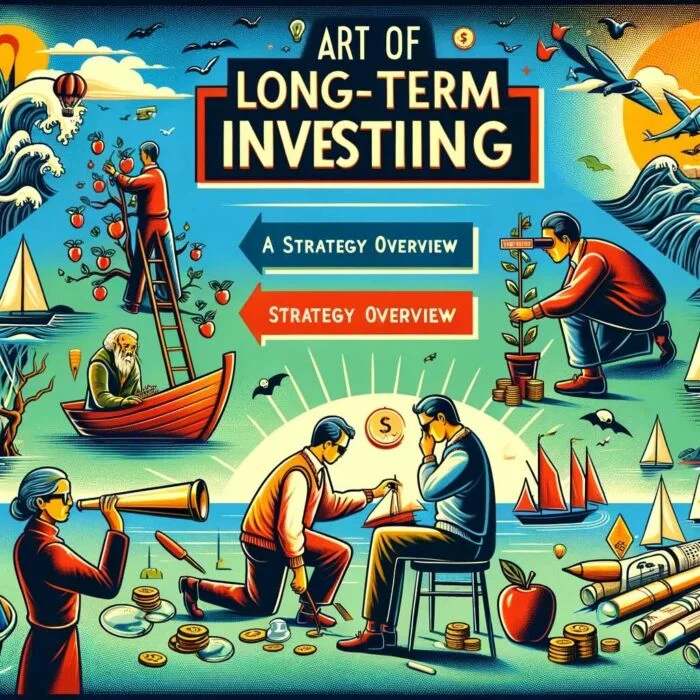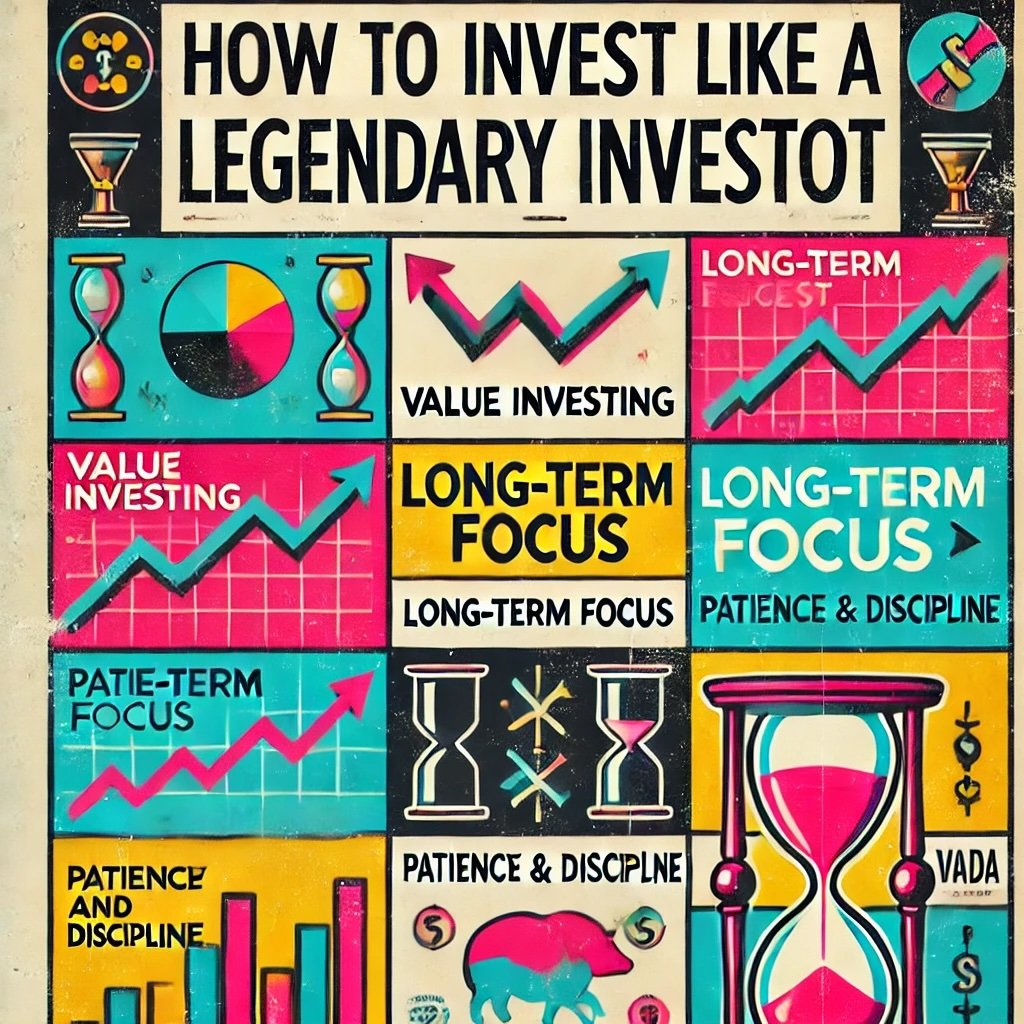Warren Buffett, also fondly known as the ‘Oracle of Omaha,’ is an investing legend whose name has become synonymous with successful long-term value investing. Born in 1930 in Omaha, Nebraska, he developed a keen interest in business and investing at a remarkably young age. After graduating from Columbia Business School and a short stint at Benjamin Graham’s investment firm, he established Buffett Partnership Ltd., where he honed his unique investing style.

His firm eventually acquired a textile manufacturing company, Berkshire Hathaway, which became the primary investment vehicle through which Buffett would amass one of the world’s greatest fortunes. Buffett’s extraordinary success over the decades has made him a figure of immense interest and respect in the global financial community.

Concept of long-term investing
Long-term investing is a strategy or approach that involves buying and holding investments for a significant period, typically for years or even decades. The fundamental idea behind this strategy is that in the long run, good businesses will increase in value. It offers the advantage of time, allowing investment holdings to compound and grow exponentially over time. The method contrasts with short-term trading, where investors buy and sell stocks within short intervals to profit from market volatility. Long-term investing also tends to be less risky as it is less affected by short-term market fluctuations and offers more time for recovery in case of a downturn.

Long-term investing from Buffett’s perspective
To Warren Buffett, long-term investing isn’t just a strategy; it’s a philosophy. Buffett is often quoted as saying, “Our favorite holding period is forever,” exemplifying his commitment to a long-term perspective. He firmly believes that the best way to achieve significant returns in the stock market is to buy great businesses at reasonable prices and then hold on to them for as long as possible. His emphasis on long-term investing springs from the principles of compound interest, or the snowball effect, where earnings generate even more earnings over time.

Buffett often states that the stock market is a device for transferring money from the impatient to the patient. He looks at each investment as buying a piece of a business, rather than just a tradable stock, which encourages a longer-term perspective. His steadfast focus on long-term investing, coupled with an unparalleled knack for selecting undervalued yet fundamentally strong businesses, has been the cornerstone of his immense success. It’s a testament to his conviction that investing is most intelligent when it is most businesslike, underlining the importance he places on understanding the companies he invests in deeply and holding onto these investments over a substantial period.

The Principles of Warren Buffett’s Investing Strategy
Understanding the value investing strategy

Definition of value investing
Value investing is a strategy that involves buying stocks that appear to be trading for less than their intrinsic or book value. It’s about hunting in the stock market for bargains, the equivalent of looking for items on sale at a store. Value investors actively seek stocks they believe the market has undervalued. The idea is that markets overreact to good and bad news, resulting in stock price movements that do not correspond with a company’s long-term fundamentals. The overreaction offers an opportunity for value investors to profit by buying when the price is deflated.

Buffett’s approach to value investing
Warren Buffett is, perhaps, the most well-known disciple of the value investing school, though he has added his unique spin to it. Buffett was a student of Benjamin Graham, often touted as the father of value investing. While he absorbed Graham’s lessons on investing with a margin of safety and focusing on a company’s intrinsic value, Buffett’s approach deviated somewhat from his mentor’s.
Buffett focuses on buying ‘wonderful companies at fair prices’ rather than ‘fair companies at wonderful prices,’ as Graham might have advised. He appreciates the power of brand names, durable competitive advantage, and capable management, factors that Graham did not emphasize. Buffett looks for companies with excellent long-term prospects, rather than just cheap stocks.
Buffett’s approach is patient and disciplined, refusing to follow market trends and always waiting for the right opportunity to buy great companies. He once said, “The stock market is filled with individuals who know the price of everything, but the value of nothing,” a sentiment that perfectly encapsulates his investing philosophy. His willingness to go against the grain, his patience, and his focus on value rather than price are hallmarks of his investing style.
Buffett’s unique approach to value investing has resulted in an enviable track record. His ability to dissect a company’s financials, understand its business model, and then determine if the market price offers value is legendary. He prides himself on making big bets when he believes he has found a company that offers long-term value, demonstrating a confidence in his ability to discern value where others may not. This confidence, born of diligent analysis and a deep understanding of business, is at the heart of Buffett’s value investing approach.
source: moneycontrol on YouTube
The importance of a company’s intrinsic value
Explanation of intrinsic value
Intrinsic value, in the context of investing, refers to the perceived actual value of a company or a stock, considering all aspects of the business and its fundamentals, and not just the current market price. It takes into account a multitude of factors such as the company’s earnings power, its assets, the nature of its industry, and the quality of its management. Determining intrinsic value often involves complex financial analysis and forecasting of future profits and cash flows. The concept serves as the foundation for value investing, which posits that occasionally, the market price of a stock diverges from its intrinsic value, presenting opportunities for profit.

Buffett’s approach to determining intrinsic value
Warren Buffett’s approach to intrinsic value is rooted in his understanding of businesses and his ability to project their future performance. Buffett considers intrinsic value as the discounted value of the cash that can be taken out of a business during its remaining life. He is less concerned with the fluctuations in the stock price and more focused on the company’s long-term ability to generate cash flow.
He looks at various fundamental factors to determine a company’s intrinsic value. These include the company’s earnings power, the quality of its management, the nature of its industry, and the durability of its competitive advantage, or its ‘economic moat.’ A significant factor is the company’s return on invested capital (ROIC) – Buffett prefers companies that generate high returns on their capital and can reinvest their earnings at similarly high rates.
Buffett combines this detailed analysis with his characteristic patience. He acknowledges that determining intrinsic value isn’t an exact science and that it involves a range of probable outcomes. The precision isn’t as important as getting the general direction right.
He once stated, “It is better to be approximately right than precisely wrong.” And therein lies the secret to his approach: Buffett doesn’t try to be precisely right about a company’s intrinsic value; instead, he aims to buy companies for significantly less than they are worth, thereby incorporating a margin of safety.
Buffett’s way of determining intrinsic value goes beyond numbers. His understanding of human psychology, management quality, and industry dynamics play a vital role. His approach emphasizes that investing is as much an art as it is a science.
source: The Financial Review on YouTube
The margin of safety
Explanation of margin of safety
The concept of a “margin of safety” in investing is often attributed to Benjamin Graham, widely recognized as the father of value investing and Warren Buffett’s mentor. The margin of safety is essentially a principle that encourages investors to only purchase securities when their market prices are significantly below their calculated intrinsic value. The difference between the market price and intrinsic value serves as the margin of safety. This concept is based on the premise that investing in securities encompasses some level of risk, and it’s prudent to account for potential errors in judgment or unforeseen events.

Buffett’s approach to the margin of safety
Warren Buffett holds the principle of the margin of safety in high regard. He views it as a buffer against the uncertainties and the inherent unpredictability of investing. In his 1992 letter to Berkshire Hathaway shareholders, he wrote, “We insist on a margin of safety in our purchase price. If we calculate the value of a common stock to be only slightly higher than its price, we’re not interested in buying.”
This sentiment reflects his cautious approach and his keen appreciation for risk management. Buffett has often compared the margin of safety to driving across a bridge. “You don’t try to drive across a bridge that says ‘Capacity: 15,000 pounds’ with a truck weighing 14,999 pounds,” he famously quipped. “You go down a little more and find a bridge that says ‘Capacity: 20,000 pounds,’ and that’s the one you drive across.”
Buffett’s perspective on the margin of safety also ties in with his value investing philosophy. He believes that value comes from buying a business for less than it’s worth. The gap between value and price is where the margin of safety lies. The larger this gap, the larger the margin of safety, and the lower the risk from Buffett’s standpoint.
In essence, the margin of safety serves two purposes in Buffett’s investment strategy. It provides a buffer against errors in the calculation of intrinsic value or against unexpected negative events. And secondly, it is a tool to ensure he only invests in businesses whose value is unmistakably greater than their market price. For Buffett, the margin of safety isn’t just a method of risk management; it’s a cardinal rule of investing.
source: The Long-Term Investor on YouTube
The approach to market volatility
Buffett’s view of the stock market
Warren Buffett has a unique and detached perspective on the stock market. Unlike many investors who are swayed by market trends and short-term price movements, Buffett regards the market as a means to an end rather than an indicator of a company’s value. He likens the stock market to a voting machine in the short term and a weighing machine in the long term. In the short term, popularity (voting) drives stock prices, but in the long term, only substance (weight or intrinsic value) matters.

Buffett also uses the metaphor of ‘Mr. Market,’ a concept borrowed from his mentor, Benjamin Graham. He views ‘Mr. Market’ as an erratic, bipolar character who swings between unbounded optimism and deep pessimism. The key to dealing with ‘Mr. Market,’ as per Buffett, is to use his mood swings to your advantage rather than getting carried away by them.
How Buffett leverages market volatility for long-term gains
Buffett’s detachment from the whims of the stock market does not mean he ignores it. On the contrary, he uses market volatility as an opportunity to buy great businesses at discounted prices. He sees market downturns, not as disasters, but as sales where investors can buy quality stocks at markdown prices.
Buffett’s famous adage, “Be fearful when others are greedy and greedy when others are fearful,” perfectly encapsulates his approach to market volatility. He leverages market downturns and periods of high volatility to buy stocks of good companies at lower prices, effectively employing the market’s mood swings for his benefit.
A prime example of this is his actions during the 2008 financial crisis. When panic selling caused many stock prices to plummet, Buffett invested billions into companies like Goldman Sachs and General Electric, recognizing the disparity between their market prices and their intrinsic values.
By treating market volatility as a friend rather than a foe, Buffett turns conventional wisdom on its head. Instead of trying to avoid or mitigate volatility, he welcomes it, seeing it as a source of potential profit rather than a risk to be feared. His ability to keep a clear head during market upheavals, stay focused on fundamentals, and take advantage of others’ fear and confusion, allows him to use market volatility to generate long-term gains.
source: The Swedish Investor on YouTube
Buffet’s Approach to Company Analysis
Emphasis on quality of management

Importance of competent and honest management in Buffett’s strategy
Warren Buffett’s company analysis is not purely numbers-driven; he places significant emphasis on the quality of a company’s management. He believes that good management is key to the long-term success of a business. Buffett is on the lookout for management teams that are not only competent but also honest and dedicated to the interests of the shareholders.
In the words of Buffett himself, “You cannot make a good deal with a bad person.” He prefers companies run by managers who treat the money of the company as if it were their own and who make decisions based on long-term value creation rather than short-term gain. He sees management as the steward of shareholder capital, and thus, he seeks leaders who are prudent, reliable, and transparent in their capital allocation.
Case studies of Buffett’s investments where management played a significant role
One of the prime examples of the role of management in Buffett’s investments is Berkshire Hathaway’s stake in Coca-Cola. Buffett started accumulating shares in the beverage giant in 1988, not only because of the company’s brand and business model but also due to his admiration for Roberto Goizueta, Coca-Cola’s CEO at the time. Buffett admired Goizueta’s focus on shareholder value and his disciplined approach to capital allocation.
Another example is Buffett’s investment in Geico. While Buffett first bought shares of the company due to its strong business model, he was also drawn to Geico because of his admiration for Lorimer Davidson, a top executive at Geico who later became the CEO. Davidson had given a young Buffett invaluable lessons about the insurance business, and their relationship played a significant role in Buffett’s decision to eventually buy the entire company.
A more recent example involves Apple. While initially, Buffett was known for avoiding technology companies, he began accumulating Apple shares in 2016. A part of his reasoning was his respect for Apple’s management team, particularly CEO Tim Cook, for their ability to create products and maintain a loyal customer base.
In all these instances, Buffett’s analysis went beyond simple financial metrics and involved a deep dive into the character and competence of the company’s management. He knows that good management can drive a company to success, while bad management can ruin even the strongest of businesses. Buffett’s ability to assess management quality is an integral part of his success as an investor.
Importance of robust financial health
Buffet’s key financial indicators
Warren Buffett, being a value investor, scrutinizes a company’s financials before making an investment decision. There are a few key financial indicators that he particularly emphasizes. These include:
- Return on Invested Capital (ROIC): Buffett considers this as one of the most important indicators as it measures the profitability of a company relative to the capital it has invested in its business. High ROIC suggests a company that uses its capital efficiently to generate profits.
- Earnings Retention: This refers to the proportion of net income that is retained within the company rather than being distributed as dividends. Buffett likes companies that can not only retain a significant portion of their earnings but also reinvest those earnings at high rates of return.
- Debt-to-Equity Ratio: Buffett prefers companies with low debt-to-equity ratios as high debt can increase a company’s risk profile. He is particularly cautious about financial leverage and its potential to magnify losses.
- Operating Margin: A high operating margin indicates a company that can convert a large portion of its revenue into profits. It suggests that the company has strong pricing power or good control over its costs, or both.
How Buffett uses these indicators to determine financial health
Buffett uses these financial indicators as a lens through which to view a company’s financial health. He uses ROIC to gauge how effectively a company uses its capital. A high ROIC is often an indicator of a company with a strong competitive advantage or ‘economic moat’.
In terms of earnings retention, Buffett considers not just the amount of earnings a company retains, but how effectively it can reinvest those earnings. If a company can reinvest its retained earnings at high rates of return, it can grow its intrinsic value over time, which is exactly what Buffett looks for.
For debt-to-equity ratio, Buffett’s aversion to high levels of debt stems from his cautious approach to investing and his focus on preserving capital. A company with low debt is less risky because it is less likely to face financial distress or bankruptcy.
Buffett views the operating margin as an indicator of a company’s operating efficiency and its competitive advantage. High operating margins can suggest that a company has a unique product or service for which it can charge premium prices, or that it is exceptionally good at controlling costs. Both scenarios suggest a company with a strong competitive position and robust financial health.
Buffett’s use of these indicators is not simply a mechanical exercise; it’s part of his broader approach to understanding a company’s business model, competitive position, and growth prospects. These financial indicators are tools that help him to discern a company’s quality and its potential to create long-term value.
source: Investor Talk on YouTube
Understanding durable competitive advantage
The concept of an economic moat
The term “economic moat,” popularized by Warren Buffett, refers to a business’s ability to maintain competitive advantages over its competitors in order to protect its long-term profits and market share. It’s essentially a metaphor for the defensive protection that a castle’s moat provides. The wider and deeper the moat, the more difficult it is for competitors to attack and erode the company’s market position.
An economic moat can come from various sources, including brand reputation, patents, cost advantages, network effects, and high switching costs. Buffett places great emphasis on finding companies with wide economic moats because they can sustain profitability over the long term, making them ideal for his buy-and-hold investment strategy.
Examples of companies Buffett invested in with a clear economic moat
Coca-Cola is a classic example of a company with a wide economic moat that Buffett has invested in. Coca-Cola’s brand is one of the most recognized worldwide, which gives it immense pricing power. Moreover, its extensive distribution network makes it difficult for competitors to match Coca-Cola’s reach.
Another company that exemplifies a wide economic moat is See’s Candies. While it might not be a large part of Berkshire Hathaway’s portfolio, See’s Candies holds a special place as one of Buffett’s favorite investments. The company’s competitive advantage comes from its strong brand reputation and customer loyalty. Consumers are willing to pay a premium for See’s Candies, which allows the company to maintain high profit margins.
Geico, another one of Buffett’s notable investments, has a cost advantage as its economic moat. By selling insurance directly to consumers, Geico is able to keep costs low and pass the savings to its customers, making it difficult for competitors to match its prices.
More recently, Apple has become one of Berkshire Hathaway’s largest holdings. Apple’s economic moat stems from its strong brand and ecosystem of products and services, which create high switching costs for users.
These companies’ wide economic moats have enabled them to earn high returns on capital over extended periods. This, in turn, has allowed them to create substantial value for shareholders, including Buffett and Berkshire Hathaway. For Buffett, an economic moat is more than just a competitive advantage—it’s a fortress that protects a company’s profitability and helps ensure its longevity.
Case Studies: Application of Buffett’s Strategy

Case Study 1: Coca-Cola
In 1988, Warren Buffett’s Berkshire Hathaway started accumulating shares in the beverage giant, Coca-Cola, eventually becoming the company’s largest shareholder. This investment turned out to be one of the most lucrative for Berkshire Hathaway.
Several factors motivated this investment. First, Coca-Cola had a strong brand that had been ingrained in consumers’ minds for decades, which reflected Buffett’s emphasis on a company’s competitive advantage or economic moat. Secondly, Coca-Cola had a high return on invested capital and a global distribution network, which allowed it to generate significant profits.
Lastly, Buffett admired the company’s management, particularly then-CEO Roberto Goizueta, for his focus on shareholder value. Over the years, Coca-Cola has continued to deliver steady dividends and capital growth, underscoring the success of Buffett’s long-term investing strategy.
Case Study 2: Berkshire Hathaway
While now synonymous with Buffett’s success, Berkshire Hathaway started as a struggling textile mill when Buffett began buying its shares in the 1960s. After clashes with the management, Buffett eventually took control of the company and transformed it into the conglomerate that it is today.
Berkshire Hathaway’s acquisition strategy reflects Buffett’s principles. It acquires companies with strong management, robust financial health, and a durable competitive advantage. Some of its most successful acquisitions, like Geico and See’s Candies, are classic examples of Buffett’s strategy at work.
Despite being a large conglomerate, Berkshire Hathaway’s operating companies function independently, with the CEOs having significant control over their operations, reflecting Buffett’s emphasis on competent management. Today, Berkshire Hathaway stands as a testament to the effectiveness of Buffett’s long-term, value-oriented approach to investing.
Case Study 3: American Express
American Express (AmEx) is another quintessential example of Buffett’s long-term investment strategy. Buffett began investing in AmEx in the 1960s following the “Salad Oil Scandal,” which caused a significant drop in the company’s stock price.
Seeing the intrinsic value of AmEx’s strong brand and its customer loyalty, Buffett recognized the market’s overreaction and invested heavily, acquiring a significant stake at a low price. Despite the scandal, American Express retained its profitable traveler’s cheque and charge card businesses, which were unaffected and continued to grow.
Over the years, AmEx has grown into one of the world’s leading credit card companies, and Buffett’s initial investment has increased manifold. Buffett’s investment in American Express is a classic example of his investing adage – “Be fearful when others are greedy and greedy when others are fearful.” It also demonstrates his ability to separate a company’s temporary setbacks from its long-term value.
Warren Buffett’s Investment Philosophy: Takeaways for the Modern Investor
The importance of patience in investing
One of the most significant lessons from Warren Buffett’s investing strategy is the value of patience. Buffett is a firm believer in the “buy and hold” strategy, which involves purchasing stocks in high-quality companies and holding them for many years, often decades.
He often quotes his favorite holding period as “forever,” emphasizing the need to let investments grow over time rather than chasing quick returns. This patience allows the power of compound interest to work its magic, leading to significant wealth creation in the long run.

Lessons from Buffett’s approach for today’s market
Buffett’s principles hold valuable lessons for today’s investors, especially given the increasingly short-term focus in the market. Buffett’s emphasis on understanding a company’s business, assessing its management quality, evaluating its financial health, and identifying its competitive advantages is a reminder that investing should be about acquiring part-ownership in a business, not just buying a stock.
His approach also underscores the importance of not being swayed by market volatility. By treating market downturns as opportunities rather than threats, Buffett reminds investors to focus on a company’s intrinsic value rather than its market price.
Lastly, his adherence to a disciplined investing strategy, irrespective of market trends or popular opinion, teaches the value of conviction and independent thinking in investing.
Applying Buffett’s principles in the age of technology and rapid market changes
Buffett’s investing principles can still be applied in today’s age of technology and rapid market changes, albeit with some adaptations.
While Buffett has traditionally avoided investing in technology companies due to their lack of predictability and durability, his recent investments in companies like Apple and Amazon show that the principles of sound management, strong financials, and competitive advantages can still be applied, even within the technology sector.
Buffett’s principles remind investors to look beyond short-term trends and focus on companies that can sustain their competitive advantages in the face of technological disruption and changing consumer behavior. His emphasis on intrinsic value remains highly relevant, as it encourages investors to differentiate between companies that are genuinely creating value and those that are merely riding the wave of technological hype.
In the face of rapid market changes, Buffett’s preference for companies with robust financial health becomes even more crucial, as these companies are better equipped to withstand uncertainties and invest in future growth opportunities.
In summary, despite the changing investment landscape, the core principles of Buffett’s investing philosophy remain as applicable and valuable today as they were when he first started investing more than half a century ago.
Warren Buffett and the Art of Long-Term Investing — 12-Question FAQ
1) What does “long-term investing” mean in Buffett’s world?
Owning pieces of great businesses for years or decades, letting fundamentals and compounding—not short-term quotes—drive results.
2) How does Buffett define “intrinsic value”?
The discounted value of cash a business can generate over its lifetime. If price is well below that estimate, he’s interested.
3) What is a “margin of safety,” and why is it non-negotiable?
Buying meaningful discounts to intrinsic value to protect against errors, surprises, and cycles. No cushion, no deal.
4) What makes a company “wonderful” vs. merely “cheap”?
Durable economic moat (brand, network effects, cost advantage, switching costs), high ROIC, pricing power, and able, honest management.
5) Which financial metrics does Buffett care about most?
ROIC (with real cash returns), consistent free cash flow, sensible leverage (low debt), stable/growing margins, and rational capital allocation.
6) How does Buffett think about market volatility?
Volatility is a feature, not a bug—a chance to buy quality on sale. In the short run it’s a voting machine; in the long run, a weighing machine.
7) How important is management quality?
Critical. Look for integrity + competence + owner-orientation: clear capital allocation, prudent leverage, candid communication, and aligned incentives.
8) How does Buffett value growth?
He pays for profitable, durable growth—businesses that can reinvest at high returns for a long time, not just fast topline expansion.
9) What’s the practical screening checklist for a Buffett-style pick?
Simple model you understand; wide moat; 10+ years of attractive economics; clean balance sheet; predictable cash flows; buy below a conservative value.
10) How should an investor act during drawdowns?
Stick to process: revisit thesis & value, not price. Trim only if the business case breaks; otherwise, consider adding within risk limits.
11) Can Buffett’s principles work for tech and fast-changing sectors?
Yes—if you can underwrite durability (ecosystems, switching costs, network effects) and leadership quality. Apply the same moat + cash + price test.
12) What are the biggest mistakes to avoid?
Chasing fads, overpaying, straying outside your circle of competence, ignoring balance-sheet risk, and selling winners too soon.

Conclusion: Warren Buffett’s long-term investing strategy
Warren Buffett’s long-term investing strategy is rooted in the principles of value investing, a philosophy he adopted from his mentor, Benjamin Graham. Buffett’s approach involves a meticulous analysis of a company’s financials, the quality of its management, and the durability of its competitive advantage or economic moat. His investment decisions are guided by the company’s intrinsic value and its ability to create shareholder value over the long term.
Benefits and challenges of following Buffett’s investing approach
Following Buffett’s approach to investing can yield significant benefits. It emphasizes rational decision-making based on thorough analysis rather than emotional reactions to market fluctuations. It also advocates for a long-term view, which can result in substantial wealth creation through the power of compound interest.
However, implementing Buffett’s strategy is not without challenges. It requires deep business understanding, patience, discipline, and the willingness to go against the crowd when necessary. Furthermore, while Buffett’s strategy has been remarkably successful for him, it’s important to remember that each investor’s situation and risk tolerance are unique, and a strategy that works for one may not work for another.
Art of long-term investing as exemplified by Buffett
The art of long-term investing, as exemplified by Warren Buffett, is a testament to the value of patience, discipline, and independent thinking in the investment world. It reminds us that investing is not merely about predicting market trends or timing buy and sell decisions perfectly, but about understanding the fundamental value of businesses.

Buffett’s philosophy of buying shares in quality businesses and holding onto them for a long time has made him one of the most successful investors in history. It serves as a reminder that in the midst of rapid technological changes and market volatility, the principles of sound, long-term investing remain consistent.
While investing styles and strategies may evolve over time, the wisdom inherent in Buffett’s approach to long-term investing remains a timeless guide for investors. Whether you’re a seasoned investor or just starting your investment journey, the principles that have guided Buffett’s career offer invaluable lessons on navigating the complexities of the investment world.
Important Information
Comprehensive Investment Disclaimer:
All content provided on this website (including but not limited to portfolio ideas, fund analyses, investment strategies, commentary on market conditions, and discussions regarding leverage) is strictly for educational, informational, and illustrative purposes only. The information does not constitute financial, investment, tax, accounting, or legal advice. Opinions, strategies, and ideas presented herein represent personal perspectives, are based on independent research and publicly available information, and do not necessarily reflect the views or official positions of any third-party organizations, institutions, or affiliates.
Investing in financial markets inherently carries substantial risks, including but not limited to market volatility, economic uncertainties, geopolitical developments, and liquidity risks. You must be fully aware that there is always the potential for partial or total loss of your principal investment. Additionally, the use of leverage or leveraged financial products significantly increases risk exposure by amplifying both potential gains and potential losses, and thus is not appropriate or advisable for all investors. Using leverage may result in losing more than your initial invested capital, incurring margin calls, experiencing substantial interest costs, or suffering severe financial distress.
Past performance indicators, including historical data, backtesting results, and hypothetical scenarios, should never be viewed as guarantees or reliable predictions of future performance. Any examples provided are purely hypothetical and intended only for illustration purposes. Performance benchmarks, such as market indexes mentioned on this site, are theoretical and are not directly investable. While diligent efforts are made to provide accurate and current information, “Picture Perfect Portfolios” does not warrant, represent, or guarantee the accuracy, completeness, or timeliness of any information provided. Errors, inaccuracies, or outdated information may exist.
Users of this website are strongly encouraged to independently verify all information, conduct comprehensive research and due diligence, and engage with qualified financial, investment, tax, or legal professionals before making any investment or financial decisions. The responsibility for making informed investment decisions rests entirely with the individual. “Picture Perfect Portfolios” explicitly disclaims all liability for any direct, indirect, incidental, special, consequential, or other losses or damages incurred, financial or otherwise, arising out of reliance upon, or use of, any content or information presented on this website.
By accessing, reading, and utilizing the content on this website, you expressly acknowledge, understand, accept, and agree to abide by these terms and conditions. Please consult the full and detailed disclaimer available elsewhere on this website for further clarification and additional important disclosures. Read the complete disclaimer here.





